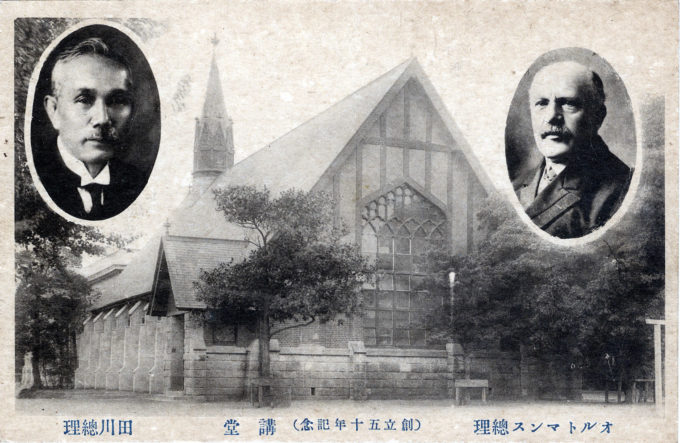
“50th Anniversary of the Founding”, Meiji Gakuin University, Tokyo, 1913. General Administration Building. Inset photos: (left) Dr. Ibuka Kajinosuke, Chancellor; (right) Dr. James C. Hepburn, Founder.
See also:
Meiji Gakuin University, Shirokane, Tokyo, c. 1920.
“You may have wondered just what sort of a school Meiji Gakuin is … It is a school for boys that in the early days was supported from the foreign side by three missions – the Scottish Presbyterian, the American Presbyterian and the Dutch Reformed Missions. At present [1912] the last two, with the Japanese, are carrying on the work.
“… There are about 350 students, all told just now, with thirty-five Japanese teachers and lecturers on the pay roll, and six foreigners, three of each mission.
“Almost all of the teaching done by us foreigners is in English. Our teaching in the Middle Department is the English language itself, but in the higher department, we foreigners use English to teach other branches.
“… In buildings, we have a chapel, a theological department with library, upper department building, a middle school building, a gymnasium unfurnished with western appliances, and, in process of erection, a dormitory, eating hall, and bath house, to take the place of those recently destroyed by fire.
“All the buildings, generally speaking, have been put up by foreign and Japanese money, the proportion of payments being about five dollars of foreign money to one dollar of Japanese money. There are four foreign and three Japanese houses on the compound which presents a fine appearance in its setting of pines and palms.
“We are a private school given partial recognition by the government, and so granted postponement of conscription of our students until after their graduation, and our graduates can try on equal terms with anyone for entrance into the higher government schools.
“… If you ask me whether I think it is worth my while to put my life in such a school and such a work, I answer, decidedly and unhestitantly, yes.
“Much better men than I have died in this service and much better men than I are living in it. And I enjoy the work. There are as many opportunities for service as a whole family could wish for, and what more does a man want? All the results in an intellectural and spiritual way are not visible and sometimes ingratitude or unappreciative students are met with, but where is that not the case?
“If it is worth while to teach youth in America, it is just as much worth while in Japan, and more so.”
– “What the Meiji Gakuin Is”, by W.E. Hoffsomer, The Mission Field, September 1912

“50th Anniversary of the Founding”, Meiji Gakuin University, Tokyo, 1913. The Chapel. Inset photos: (left) Tagawa Daikichirō; (right) Rev. Albert Oltmans, D.D. Tagawa at the time was Director of the Tokyo YMCA but would become president of the university in 1925. Rev. Oltmans was a popular professor who was also actively involved in the Japan Peace Society and the American Peace Society of Japan.
- “50th Anniversary of the Founding”, Meiji Gakuin University, Tokyo, 1913. High School Building.
- “50th Anniversary of the Founding”, Meiji Gakuin University, Tokyo, 1913. Hepburn House.
- “50th Anniversary of the Founding”, Meiji Gakuin University, Tokyo, 1913. Middle School Building.
- “50th Anniversary of the Founding”, Meiji Gakuin University, Tokyo, 1913. School of Theology.
- “50th Anniversary of the Founding”, Meiji Gakuin University, Tokyo, 1913. Sandham Hall.
- “50th Anniversary of the Founding”, Meiji Gakuin University, Tokyo, 1913. Saens Hall.







